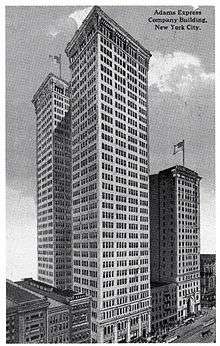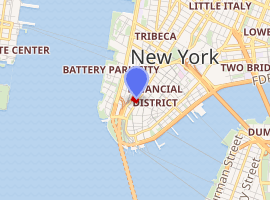Adams Express Building
The Adams Express Building is an office building owned by RXR Realty and located at 61 Broadway in the Financial District of Manhattan, New York City. The building's primary frontage is on 57-61 Broadway, with additional frontage along 33–41 Trinity Place. Architect Francis Kimball designed the 32–story building for the Adams Express Company.
| Adams Express Building | |
|---|---|
 A 1914 postcard featuring the Adams Express Co. Building | |

| |
| General information | |
| Type | Office |
| Architectural style | Palazzo[1] |
| Location | Financial District, Manhattan |
| Address | 61 Broadway |
| Town or city | New York, New York |
| Coordinates | 40°42′25.15″N 74°0′45.71″W |
| Construction started | 1912 |
| Completed | 1914[2] |
| Cost | 1914: $2,000,000 1998: $58,000,000 |
| Owner | RXR Realty [3] |
| Height | 443 ft (135.0 m)[4] |
| Technical details | |
| Structural system | Steel |
| Material | Terracotta facade |
| Floor count | 32 |
| Floor area | 670,000 sq ft (62,245 m2)[5] |
| Design and construction | |
| Architect | Francis H. Kimball |
| Main contractor | Robert E. Dowling |
Construction began in 1912 at which point the cost was estimated at $2,000,000.[6] Upon completion in 1914, the building was the seventh tallest structure in Manhattan. Construction required 3,300 tons of steel and over a million square feet of terracotta. The New York Times described the architectural style as "Florentine" below the fifth floor, and "severely simple" above.[5] Another critic called the style "utterly utilitarian,"[4] but the New York City Landmarks Preservation Commission identified the architecture as palazzo.[1]
Background
The Adams Express Company occupied part of the Pinkerton Building at 57-59 Broadway. In 1903, there was discussion of combining 57-61 Broadway with an adjacent property occupied by American Express and Wells Fargo, and building one large building for the three companies.[7] This did not happen, and American Express's adjacent building at 65 Broadway was completed in 1917.[8]
A 1904 fire that began in the basement of the Morris Building at 63 Broadway, damaged the Pinkerton and other buildings on the block. Twenty-four engines and six hook and ladder companies responded.[9] The Fire Department of New York recorded that the Adams Express Company building was destroyed,[10] but Adams Express continued to occupy the site.
By 1906, Adams Express was planning a new, fireproof building to be constructed on the site of the Pinkerton Building.[11]
Construction
In 1910 Industrial World Magazine reported that Adams Express was proceeding with a 10-story, brick and limestone building designed by George K. Hooper of Hooper-Faulkenau Engineering Company.[5] Then in 1911, Adams Express finally purchased The Pinkerton Building.[12] Although Hooper's plans would have blended with existing buildings in the Wall Street area where, in 1912, nearly half of the buildings were five stories or lower,[2] the Hooper design was never constructed. Apparently it was too small for the times ahead.
When construction began in 1912 on the straight up, 32-story Francis Kimball design, first The New York Times and later city planners became concerned about sunlight and airspace.[5] The Adams Express Building was one of a growing number of behemoths, most notably the then-under-construction Equitable Building,[13] that cast shadows not only on the street but on nearby smaller buildings and drove down real estate value, rent, and tax revenues. F.W. Fitzpatrick complained that the Adams Express Building cast an 875-foot shadow.[14] The 1916 Zoning Resolution provided a remedy in the form of setbacks where new buildings would be stepped back at certain heights depending on the width at the street. The restrictions would have applied to 75% of the ground area of the building, but construction of the Adams Express Building had occurred before the new zoning restrictions were adopted.
Later history
The building sustained heavy damage in 1916 when 300 windows were blown out in the Black Tom explosion.[5]
When the building was purchased by Metropolitan Life Insurance Company in 1988, an engineer discovered goldfish living in a pool of water below the basement heating system. Since that time, building engineers have fed the fish as a part of their regular maintenance routine. [5]
References
- "Cunard Building" (PDF). New York City Landmarks Preservation Commission. September 19, 1995. p. 7. Retrieved May 18, 2020.
- Landau, Sarah Branford (1996). Rise of the New York Skyscraper (First ed.). New Haven, Connecticut: Yale University Press. pp. 395. ISBN 978-0300064445.
- "Historic downtown tower fetches $330M". Crain's New York Business. Retrieved April 6, 2015.
- "Adams Express Company Building". The Woolworth Building @100. The Skyscraper Museum. Retrieved August 11, 2011.
- "The 1914 Adams Express Buildling -- 61 Broadway". Daytonian in Manhattan. September 22, 2011. Retrieved August 11, 2014.
- Office for Metropolitan History, "Manhattan NB Database 1900-1986," (February 7, 2010)
- "BROADWAY REALTY DEAL; American Express Company Buys Harmony Estate Property. Price for 63 and 65 to be About $2,350,- 000 -- American and Adams Companies May Erect Joint Building". The New York Times. November 27, 1902. ISSN 0362-4331. Retrieved January 24, 2020.
- "American Express Company Building" (PDF). New York City Landmarks Preservation Commission. December 12, 1995. p. 1. Retrieved January 24, 2020.
- "Big Fire in New York: Downtown District Threatened with Destruction". Geneva Daily Times. Geneva, New York: Geneva Printing Co. March 26, 1904. p. 1. Retrieved August 12, 2014.
- Boucher, Mike. "What Happened on This Day". The Month of March. The Unofficial Home Page of FDNY. Retrieved August 12, 2014.
- "New York City Notes", The Express Gazette, 31 (1): 26, January 15, 1906 [1873]
- "Adams Express Company Buys 57 Broadway". The New York Times. New York, New York: The New York Times Company. May 24, 1911. Retrieved August 12, 2014.
- Nash, Eric P. (2010). Manhattan Skyscrapers. New York: Princeton Architectural Press. p. 25. ISBN 978-1568989679.
- Fitzpatrick, Francis (December 1919), "Cutting Steps in the Skyscraper", Popular Science, 95 (5), p. 52, retrieved August 20, 2014
External links
| Wikimedia Commons has media related to Adams Express Building. |